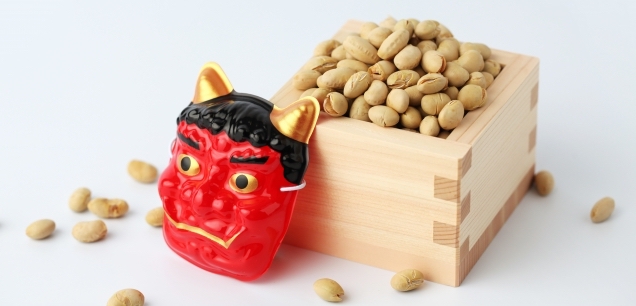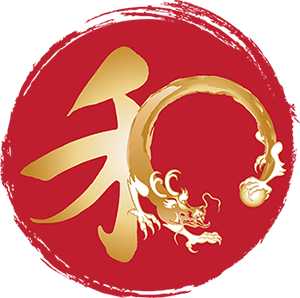READING TIME: 5 MINUTES.
When is Setsubun
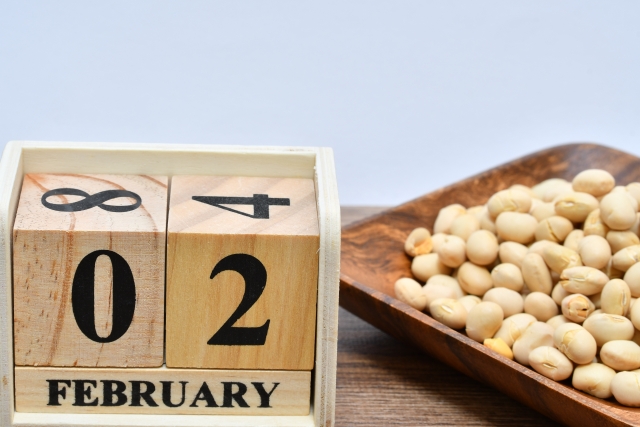
Something I love about life in Japan are the seasonal festivals and celebrations. Almost every month has its unique celebration and to me that adds a sweet rhythm to the flow of life in this country. There is always something enjoyable to look forward to. The festival for February is called Setsubun. Literally translated that means ‘the day dividing the seasons.’ According to the Japanese Lunar calendar it marks the end of winter and for the last 123 years it had fallen on February 3rd. This year, in a similar way to a leap year the date was adjusted so, for the first time in generations we celebrated Setsubun on February 2nd. But how can winter end so early, you may ask and how the day was decided? Here are some answers to that.
The day separating the seasons
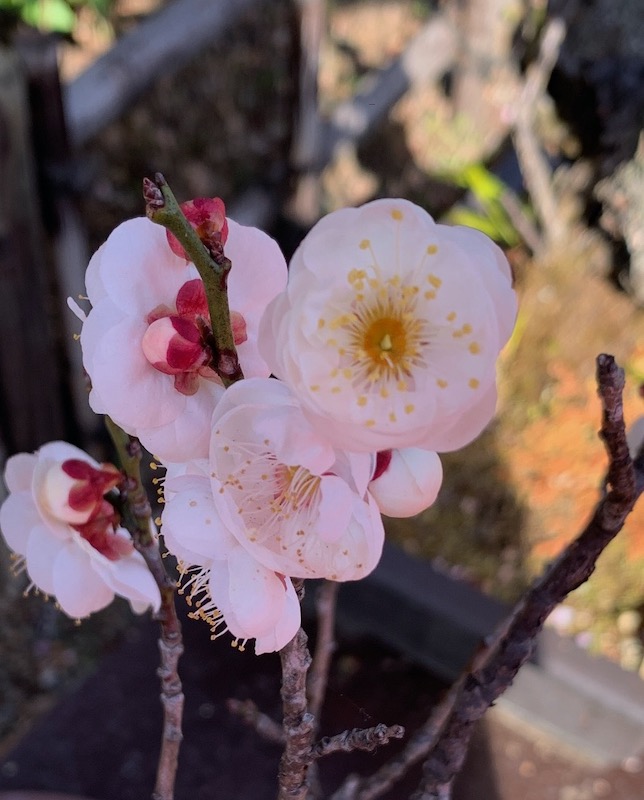 Setsubun is an interesting day. It is exactly in the middle between the Winter Solstice and the Spring Equinox. In that sense we may look at it as a day of transition, when Winter begins to fade away to be gradually replaced by the energies of Spring. Also, the traditional Japanese Lunar calendar is divided into 24 sekki. This by itself is an interesting combination of characters: 節 (Setsu) means a section and 気 (ki) is Chi or spirit, energy. I often find the Japanese language fascinating in how it expresses spiritual principles in its words (that’s a theme worthy of a blog by itself!) So it would appear that the ancient astrologers divided the year into 24 sections with a different flow of Chi. The day after Setsubun is Risshin, or the first day of Spring. Perhaps it is just my perception but it does feel as if winter is beginning to fade away: the first flowers of spring are blooming in the gardens and the plum trees are opening their blossoms too. Spring is on its way!
Setsubun is an interesting day. It is exactly in the middle between the Winter Solstice and the Spring Equinox. In that sense we may look at it as a day of transition, when Winter begins to fade away to be gradually replaced by the energies of Spring. Also, the traditional Japanese Lunar calendar is divided into 24 sekki. This by itself is an interesting combination of characters: 節 (Setsu) means a section and 気 (ki) is Chi or spirit, energy. I often find the Japanese language fascinating in how it expresses spiritual principles in its words (that’s a theme worthy of a blog by itself!) So it would appear that the ancient astrologers divided the year into 24 sections with a different flow of Chi. The day after Setsubun is Risshin, or the first day of Spring. Perhaps it is just my perception but it does feel as if winter is beginning to fade away: the first flowers of spring are blooming in the gardens and the plum trees are opening their blossoms too. Spring is on its way!
Celebrating Setsubun
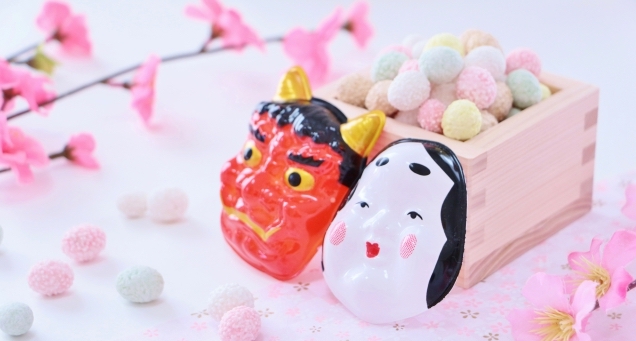 There are several fun Setsubun traditions with the most popular one being mame-maki, which in Japanese means throwing beans. The period of time surrounding the Setsubun was thought to bring the spirit world closer to the physical one. Thus, practices like mame-maki became popular. Tossing the beans is symbolic of driving away any evil spirits (Oni in Japanese,) who might have wandered too close to the physical realm. Traditionally a man from the household dresses as an Oni and puts on a scary mask. It is believed that the Oni are afraid of beans so kids trow handful of roasted soy beans at the Oni shouting: Oni wa soto! Fuku wa uchi! (Demons get out! Good luck come in!) and chase him out of the house.
There are several fun Setsubun traditions with the most popular one being mame-maki, which in Japanese means throwing beans. The period of time surrounding the Setsubun was thought to bring the spirit world closer to the physical one. Thus, practices like mame-maki became popular. Tossing the beans is symbolic of driving away any evil spirits (Oni in Japanese,) who might have wandered too close to the physical realm. Traditionally a man from the household dresses as an Oni and puts on a scary mask. It is believed that the Oni are afraid of beans so kids trow handful of roasted soy beans at the Oni shouting: Oni wa soto! Fuku wa uchi! (Demons get out! Good luck come in!) and chase him out of the house.
Charms that keep the Oni out
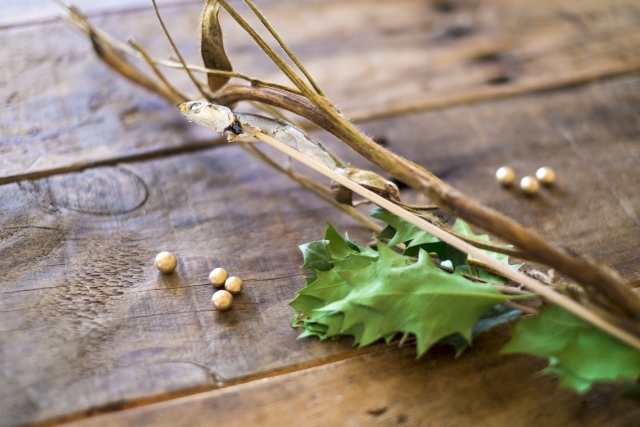
To ensure that the evil Oni will not return to the house, a special protective charm made of hiiragi (a holly-like plant with spiky leaves) and stalks of soy beans with the pods still attached, is placed at the entrance door of the house. To fortify its Oni repelling powers, the head of a dried sardine is skewered on one of the branches. According to traditional beliefs, the smell of the sardine, the spikes of the hiiragi leaves and the beans in the pods will keep the evil spirits away!
Setsubun auspicious foods
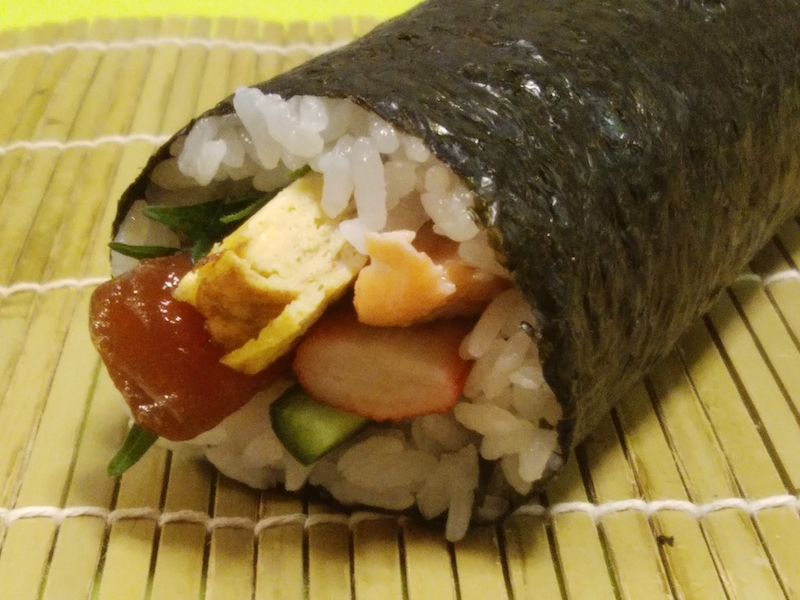 An old Setsubun tradition is to eat the number of lucky beans (Fuku-mame in Japanese) that is your age so that the year is a prosperous one for you.
An old Setsubun tradition is to eat the number of lucky beans (Fuku-mame in Japanese) that is your age so that the year is a prosperous one for you.
Another tradition that originates in the Kansai region but has recently become popular in other parts of the country too is eating Ehomaki . These are thick sushi rolls made with seven ingredients – one for each of the Seven Lucky Gods. These sushi should not be cut but should be served whole and eaten in silence facing the auspicious direction for the year. Cutting them would mean cutting off your luck and your relationships.
Temple Setsubun celebrations
If you happen to be in Japan on the Setsubun day don’t miss the special celebrations at the temples and the shrines. This year I was fortunate to observe the rituals at the Takahata Fudo temple, an unforgettable experience to me. The spirit at the temple was so upbeat and festive. There were many stalls, erected especially for the occasion that sold lucky charms, souvenirs, food and of course small bags with Fuku-mame, each with a lucky coin inside. The Fire Purification ritual that the temple is famous for was performed several times and the sound of its drums and the chanting added magic to the occasion. Then there was the solemn procession of monks, dressed in their colorful formal robes moving under the rhythm of the bells attached to the scepter of their leader – we don’t see this very often and when we do it is impressive. Bellow is a short video I took of the festivities. I couldn’t take a video of the whole event because I had a virtual tour at the same time (yes, my clients was very lucky to be ‘visiting’ the temple on that day!) but I believe it is enough to give you a taste of the festivities. And, if you want to see more of the Takahata Fudo temple through one of my live virtual tours click on the link below the video for details. For those who want to learn more about the Seven Lucky gods I added a link to my blog dedicated to them. Enjoy!
* The Spirit of Japan Tours organizes private and group tours to temples and sites where you can experience the richness of Japan’s spirituality and traditions. Please, message us for more information about our future tours.

